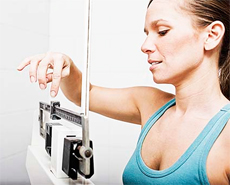|
|
BMI vs. BAI: the Hunt for a Better Tool
 The
increasing whim among women all over the world toward personal
health and fitness does not seem asynchronous with the urgency of the hour.
The hundred dollar question that still needs to be answered is why healthy
lifestyle needs to become a priority. The battery of health and fitness tools,
BMI,
body fat%,
BMR,
WTH
(Waist-to-Hip) ratio, have a new member added to the list, BAI (Body Adiposity
Index). Whichever tool you decide upon one thing that will not change is, you
health status until you make a committed effort. The
increasing whim among women all over the world toward personal
health and fitness does not seem asynchronous with the urgency of the hour.
The hundred dollar question that still needs to be answered is why healthy
lifestyle needs to become a priority. The battery of health and fitness tools,
BMI,
body fat%,
BMR,
WTH
(Waist-to-Hip) ratio, have a new member added to the list, BAI (Body Adiposity
Index). Whichever tool you decide upon one thing that will not change is, you
health status until you make a committed effort.
The calculation of BMI is defined as an individuals body weight divided by
the square of their height and is widely used to generally categorised people as
underweight, overweight or
obese.
The Body mass index does however have limitations as it does not account for
the difference between body fat percentage and
lean muscle mass. For those with a large proportion of lean muscle,
especially those that engage in intense activity and use
sports supplements such as
whey protein or weight gainers, the BMI may indicate that they may be
overweight or unhealthy.
Generally, the body mass index is therefore only a tool to measure an
average ideal weight for any given height. Alternative methods to provide more
accurate means of indicating obesity have been developed such as the body volume
index.
Recently, researchers have developed a new way to measure the body fat (Sun
Mar 6, 2011). The new obesity scale is offered due to the flaws of the BMI.
For example, BMI calculation cannot be generalized across men and women,
athletes and different ethnic groups.
 BAI
(Body Adiposity Index) focuses on height and hip measurements and calculates the
ratio of hip circumference (standing with feet together and placing the
measuring tape around the widest part of your hips) to height. BAI
(Body Adiposity Index) focuses on height and hip measurements and calculates the
ratio of hip circumference (standing with feet together and placing the
measuring tape around the widest part of your hips) to height.
Formula for BMI |

|
Formula for BAI
|
 |
The research team says, BAI still needs some fine tuning, and they still
need to test it among whites and other ethnic groups, but they think it has
promise as new
tool,
especially in remote settings with limited access to reliable scales.
The results fall under the same measurements as BMI - Over 40 is
considered morbidly obese, 30+ is considered obese, between 25 and 29.9 is
considered overweight, between 18.5 and 24.9 is considered healthy and under
18.5 is consider underweight.
Whichever health assessment tool you take on, one thing that cannot be ignored
is the fact, that being overweight is in no way healthy and needs to be honestly
pursued. Instead of relying too much on the tools, if you follow a healthy
lifestyle, inch by inch you can, cinch your health and fitness goals.
To learn more about mathematical comparison of BMI & BAI,
click here.
-
WF Team
Dated 24 November 2011
Related Links
|
|
|
|
|









